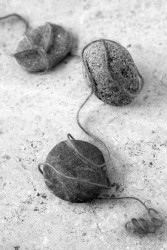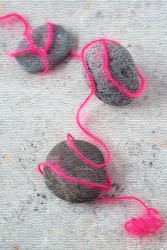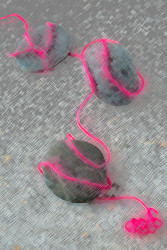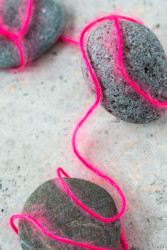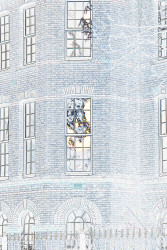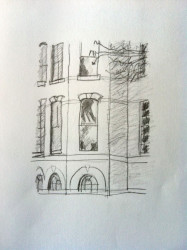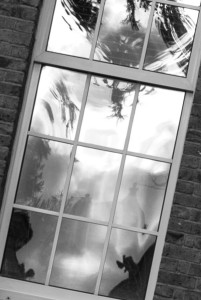Ut pictura poesis (“As is painting, so is poetry,” Horace, Ars Poetica)
Form:
The final image I chose for this exercise is a digital photograph showing three grey pebbles on a grey marble background, with pink wool laid across the stones. Two of the pebbles are relatively flat and smooth the third has more of a texture and is egg shaped. The pebbles were found some years ago and the marble is a manufactured floor tile.
Process:
Having chosen this poem it was initially difficult to move away from thinking literally – images of waves crashing, hands spread out, and bolts of cloth or even an ironing board. In a sense it was as if my mind needed to clear these ideas out before I could move on to a deeper level of reflection.
As mentioned in a previous post I then started to brainstorm my responses to the poem and read different analyses of it online. This began to conjure up a focus on texture, connections, interdependencies, the nature of the world we are living in and the challenges we face. I was particularly struck by the last line ‘chastity returns out of the foam’, as if somehow the balance in the system could or would be restored. It felt like I was moving into a more metaphorical and connotative frame for the image I wanted to create.
This led me to thinking about textures and I knew I wanted to develop something that highlighted the notion of connection, but that this connection was not formal or organised, it was soft, gentle and fragile. I started to look for a range of objects that might work, which was when I came across the pebbles. This led me to thinking about contrasting the signs of the natural stones with more overtly man made materials, also exploring textures and surfaces.
As with assignment one I also went on to experiment with different filters and techniques.
- Ode B&W
- Ode texture
- Ode sketched
- Ode cropped
This was a table top image shot in natural light with the use of one white reflector.
Content
The image is intended to be interpretative rather than illustrative and is built on the themes I took from Neruda’s poem. Looking in depth at the poem:
• It starts by talking about the purity of poetry
• I took the reference to ‘wrinkles and gathers’ as the impacts humankind is having on the earth
• Ironing signifies the desire to smooth things out, perhaps to move towards a more peaceful and balance ecology
• “…and out of light a dove is born: chastity returns from the foam.” This final section speaks to me of optimism, out of our struggles some form of healing peace is achieved
These interpretations led me to a focus on natural and man-made materials and how they might be linked. The stones are natural yet shaped by their previous environments, they have a history, two smooth and one pitted. The soft but vibrantly pink wool wraps and weaves between them, perhaps suggesting a confusion of both the man-made and the natural. It sits gently on and around the stones – a signifier of bonds or perhaps trickling water. I have deliberately left the colours muted other than the wool and placed the stones in relation to each other to show different textures and volumes, some degree of shadow is used to emphasise their qualities as objects but I wanted to keep the overall effect quite soft.
The intention is to leave the viewer with questions and the space to create their own interpretations.
When I showed the image to an archaeologist friend she came up with a new interpretation and spoke of how large, flat, heated stones were once used for smoothing cloth, a precursor to ironing as we know it, this was a symbolism I was not aware of but delighted to discover!
Evaluation & synthesis
This was an interesting exercise in a semiotic sense because it was taking one ‘text’, the poem, and creating a new text in a different form in response to it. I was making a personal translation of what was signified by the poem and creating a new set of signifiers in response. I cannot say what Neruda meant to signify by the poem but for me the image was intending to signify – connections, the natural world, and fragile relationships.
Overall, I was pleased with the final result, if I were to change anything technically it might be to change the depth of field, to bring more of the pebbles into focus. Otherwise, I hope at least some of the intended meanings are clearly communicated.
Technical
Nikon D600: FL – 70mm, 1/500s, f/4.5. ISO – 400.




